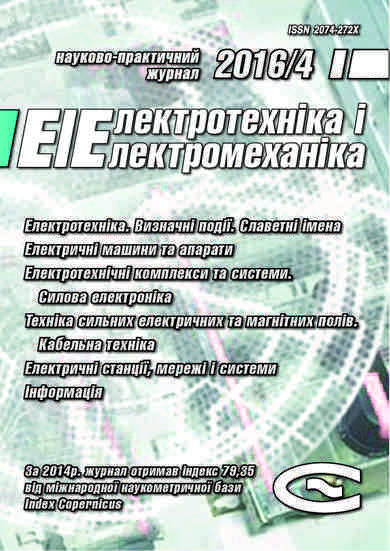FINITE ELEMENT TECHNIQUE FOR SOLUTION OF THERMO-CONTACT PROBLEMS AND ITS APPLICATION IN NUMERICAL ANALYSIS OF DEVICES WORKING WITH INDUCTION HEATING
DOI:
https://doi.org/10.20998/2074-272X.2016.4.03Keywords:
induction heating, thermoelasticity, multiphysics problems, numerical analysis, finite element methodAbstract
Purpose. To develop an effective approach for the numerical solution of transient thermo-contact problems and present a typical example of its utilization regarding devices working on the principle of thermoelasticity produced by induction heating and specific technological processes intended for assembly and disassembly of systems containing shrink fits. Methodology. A finite element technique for solution of 2D multiphysics (electromagnetic, thermal and structural) problems is developed, taking into account temperature dependences of material properties and continuous variations of the contact surfaces. Modeling of the contact interaction between two parts is based on the concept of a special contact finite element having no thickness. The functional for the temperature problem is supplemented with components corresponding to the thermal conductivity of this contact layer. The heat generated due to mutual sliding of both parts can also be taken into account, but the heat capacity (specific heat) of the contact layer is neglected. Using a special 1D 4-node finite elements a system of equations for the description of the thermo-contact problem is obtained. Originality. Relatively simple analytical formulae for calculation of the contact thermal resistances occurring in specific parts of electrical machines are known. The paper offers an alternative approach for the numerical solution of transient thermo-contact problems based on the concept of a special 1D contact finite element having no thickness. Results. The presented technique is applied for the computer simulation of assembly and disassembly of a shrink fit using induction heating. Conclusions regarding the choice of technological modes are made. Comparative computations for drills made from hard alloy and alloyed tool steel are carried out.References
1. Driesen J., Belmans R.J.M., Hameyer K. Finite-element modeling of thermal contact resistances and insulation layers in electrical machines. IEEE Transactions on Industry Applications, 2001, vol.37, no.1, pp. 15-20. doi: 10.1109/28.903121.
2. Shulzhenko N.G., Gontarowsky P.P., Matyukhin Yu.I., Pantelyat M.G., Doležel I., Ulrych B., Beneš K. Computer modeling of induction heating-based assembly and disassembly of shrink fits. Acta Techniсa CSAV, 2004, vol.49, no.2, pp. 169-183.
3. Doležel I., Karban P., Ulrych B., Pantelyat M.G., Matyukhin Yu.I., Gontarowsky P.P., Shulzhenko N.G. Limit operation regimes of actuators working on principle of thermoelasticity. IEEE Transactions on Magnetics, 2008, vol.44, no.6, pp. 810-813. doi: 10.1109/tmag.2007.916226.
4. Chari M.V.K., Salon S.J. Numerical Methods in Electromagnetism. Academic Press, New York, 2000. ISBN 978-0126157604.
5. Holman J.P. Heat Transfer, 10th edition. McGraw-Hill, New York, 2002. ISBN 978-0073529363.
6. Timoshenko S., Goodier J.N. Theory of Elasticity, 3rd Edition. McGraw Hill, New York, 1970. ISBN 978-0070701229.
7. Podgorny A.N., Gontarowsky P.P., Kirkatsch B.N., Matyukhin Yu.I., Khavin G.L. Zadachi kontaktnogo vzaimodeistviia elementov konstruktsii [Tasks of contact interaction in construction elements]. Kiev, Naukova Dumka Publ., 1989. ISBN 5-12-000891-7. (Rus).
8. Schlykov Yu.P., Ganin E.A., Carevskij S.N. Kontaktnoe termicheskoe soprotivlenie [Contact thermal resistance]. Moscow, Energiya Publ., 1977. (Rus).
Downloads
Published
How to Cite
Issue
Section
License
Copyright (c) 2016 Michael G. Pantelyat, Ivo Doležel

This work is licensed under a Creative Commons Attribution-NonCommercial 4.0 International License.
Authors who publish with this journal agree to the following terms:
1. Authors retain copyright and grant the journal right of first publication with the work simultaneously licensed under a Creative Commons Attribution License that allows others to share the work with an acknowledgement of the work's authorship and initial publication in this journal.
2. Authors are able to enter into separate, additional contractual arrangements for the non-exclusive distribution of the journal's published version of the work (e.g., post it to an institutional repository or publish it in a book), with an acknowledgement of its initial publication in this journal.
3. Authors are permitted and encouraged to post their work online (e.g., in institutional repositories or on their website) prior to and during the submission process, as it can lead to productive exchanges, as well as earlier and greater citation of published work.





